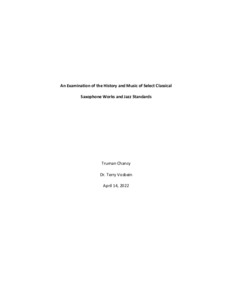An Examination of the History and Music of Select Classical Saxophone Works and Jazz Standards (thesis)

View/
Author
Chancy, Truman Thomas
Subject
Washington and Lee University -- Honors in Music
Saxophone music
Jazz
Musical analysis
Metadata
Show full item recordDescription
Thesis; [FULL-TEXT FREELY AVAILABLE ONLINE] Truman Thomas Chancy is a member of the Class of 2022 of Washington and Lee University. Altogether, an examination of the selected recital repertoire presents greater historical context of the performed works and their composers in addition to providing a musical analysis
of the pieces themselves. The classical works demonstrate the saxophone's ability to draw musical expression from the written page, both showcasing the lyrical and technical capabilities of the instrument. While raising curious questions about work's composer, the J.S. Bach Flute Sonata No. 2 represents the Baroque era despite the saxophone not being a Baroque instrument. Conversely, Paul Creston's Sonata Op.19 exemplifies an original composition for saxophone that advanced the literature for the instrument with a brisk first movement in a modified sonata-allegro form and an emotional second movement in ternary form. The collection of selected jazz standards perhaps best illustrates the variety of music
available to the saxophone. The jazz pieces allow for the most personal expression from the player, permitting them to speak their voice through their instrument. Additionally, while
analysis reveals many similarities across the chosen pieces, each one's melody, chord progression, and place on the timeline of jazz history, makes them unique. In total, the chosen
recital works, ranging from transcribed Baroque selections to jazz standards composed in the latter half of the 20th century, showcase the multi-faceted nature of the saxophone while at
their core representing the beauty of music. [From Conclusion] Truman Chancy